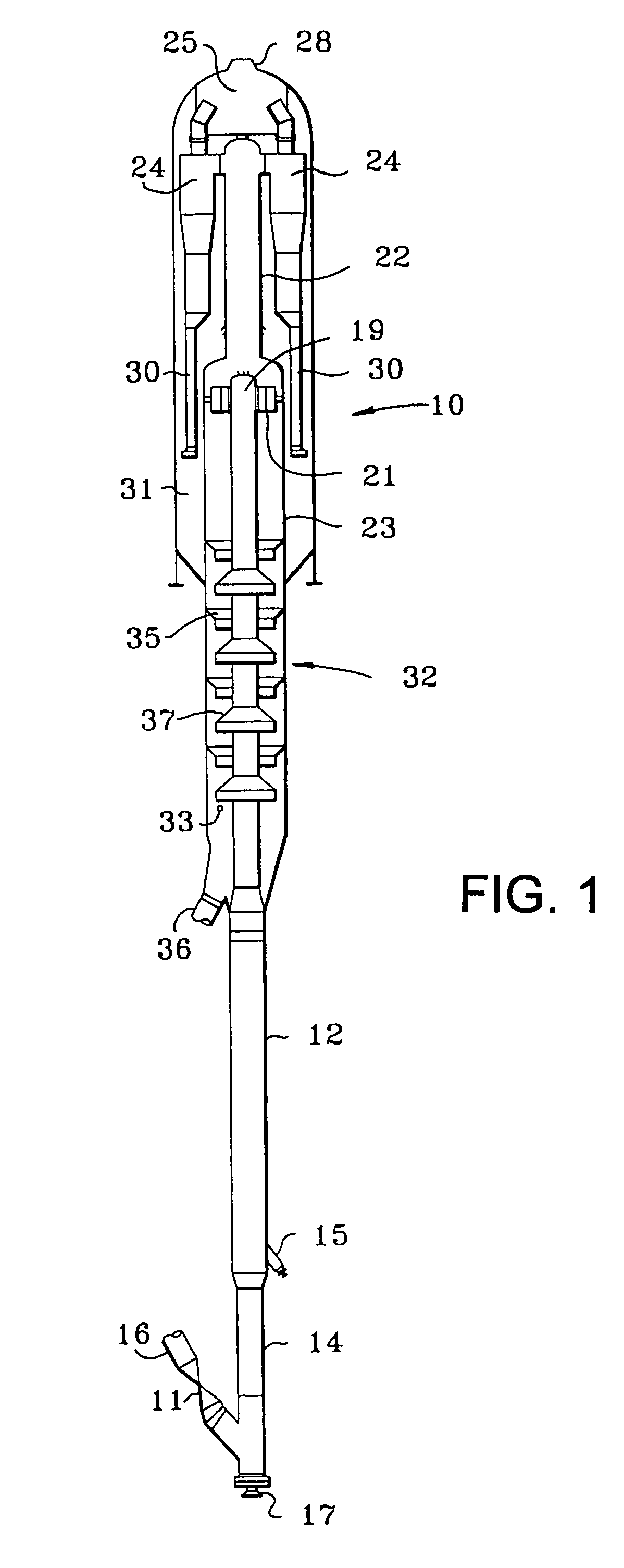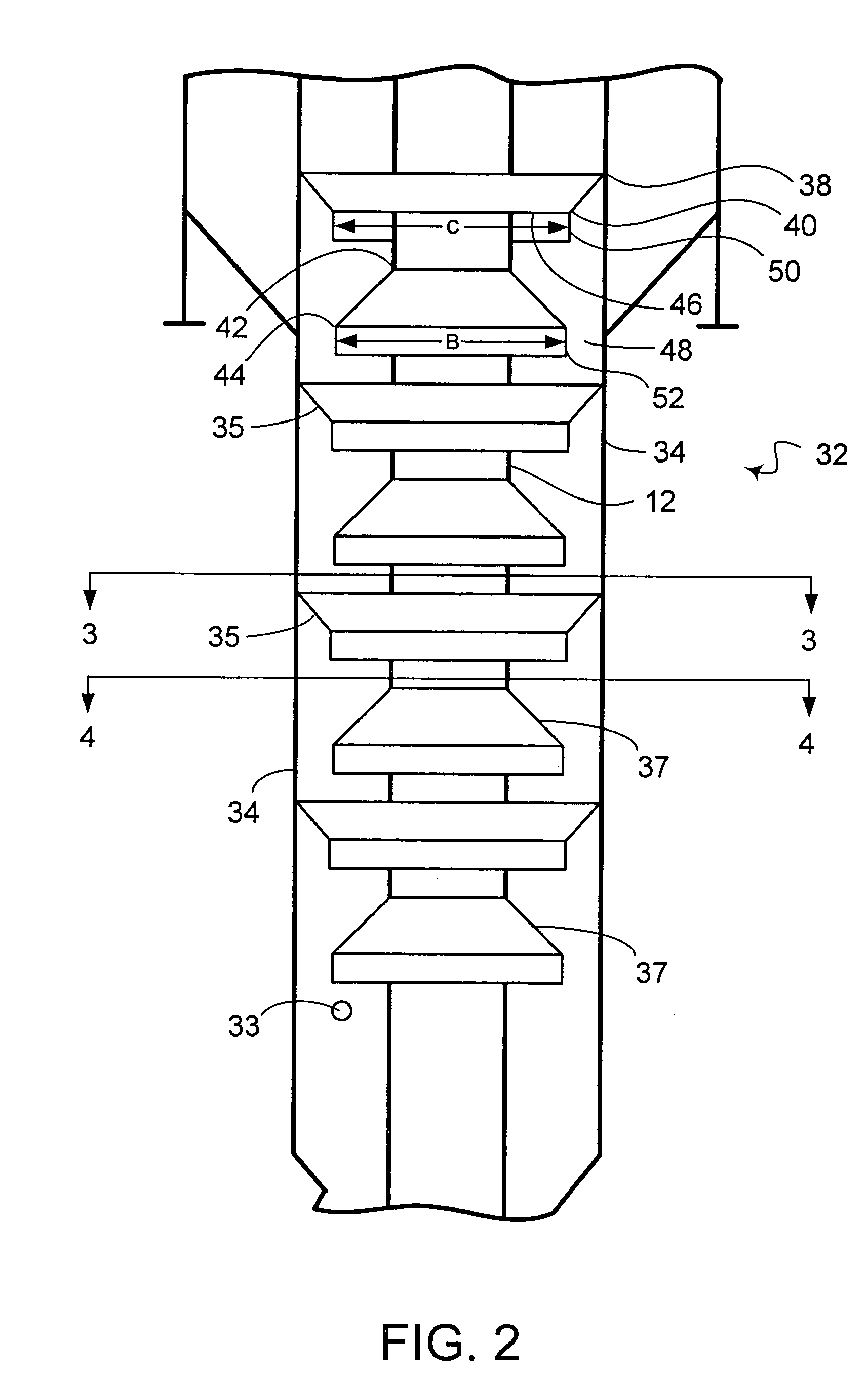Stripping process with disproportionately distributed openings on baffles
a technology of baffles and openings, applied in lighting and heating apparatus, furnace types, furnaces, etc., can solve the problems of large surface area of particles employed in fcc process, large stagnant zones occupying nearly two-thirds of stripper vessels, and large volumetric flow rate of stripping medium, so as to minimize the generation of dead zones and efficient stripping
- Summary
- Abstract
- Description
- Claims
- Application Information
AI Technical Summary
Benefits of technology
Problems solved by technology
Method used
Image
Examples
example 1
[0046]We believe that the ratio of volume of stripping medium through respective sections of the baffle is dependent upon catalyst flux rate. The following Table shows preferred ratios of volume of stripping medium distributed through top and bottom sections of the baffle at given catalyst flux rates. This data is premised on the demarking line bifurcating the top section and the bottom section of the baffle into equal areas.
[0047]
PreferredCatalystCatalystPercentage ofPreferred Percentage ofFluxFluxVolume of StrippingVolume of StrippingRateRateFluid Through TopFluid Through Bottom(lbs / hr / ft2)(kg / hr / m2)Section of Baffle (%)Section of Baffle (%)15,000 73,23010–1585–9030,000146,46015–2080–8540,000195,28020–2575–8050,000244,100~35~6560,000292,920~45~55
example 2
[0048]Baffles similar to the outer baffle 35 and the inner baffle 37 depicted in FIGS. 3 and 4, respectively, were designed to have the following performance when installed in a stripper section such as stripper section 32 shown in FIGS. 1 and 2. The opening diameter was designed to be 1.3 cm (0.5 inches) except for the top row of openings in each baffle in which the opening diameter was designed to be 1.0 cm (0.375 inches).
[0049]
Outer Baffle 35Row ofNumber ofRatio of Total Area ofTotal Volumetric FlowOpeningsOpeningsOpenings to BaffleRate per Row(FIG. 3)per RowSection per Row(m3 / s (ft3 / s))72600.00210.225 (7.91) 70600.00290.336 (11.86)68800.00390.349 (12.32)66120 0.00580.306 (10.79)
The ratio of total area of openings to area of baffle section in top section 60 including just row 72 is 0.0021 which is less than the same ratio of 0.0387 for bottom baffle section 62 including rows 66, 68 and 70. The total volumetric flow rate of row 72 of openings in top section 60 is 0.225 m3 / s (7.91 ...
PUM
| Property | Measurement | Unit |
|---|---|---|
| temperature | aaaaa | aaaaa |
| angle | aaaaa | aaaaa |
| boiling points | aaaaa | aaaaa |
Abstract
Description
Claims
Application Information
 Login to View More
Login to View More - R&D
- Intellectual Property
- Life Sciences
- Materials
- Tech Scout
- Unparalleled Data Quality
- Higher Quality Content
- 60% Fewer Hallucinations
Browse by: Latest US Patents, China's latest patents, Technical Efficacy Thesaurus, Application Domain, Technology Topic, Popular Technical Reports.
© 2025 PatSnap. All rights reserved.Legal|Privacy policy|Modern Slavery Act Transparency Statement|Sitemap|About US| Contact US: help@patsnap.com



